Israel stamps
P=have O=don’t have it




Scott: #48-50P
Issued: 24.6.1951
50th Anniversary, Jewish National Fund
 Inside #50: 1902
Jewish National Fund StampO
Inside #50: 1902
Jewish National Fund StampO
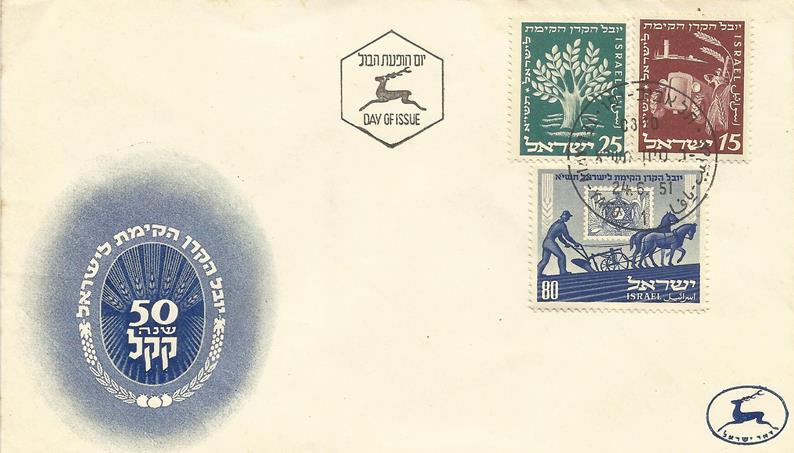


Scott: #88-9P
Issued: 13.10.1954
TABIM, National Stamp Exhibition
Inside #88-9: Pseudo Stamp on Tab


29.11.1957P
![[Citadel Tower of David, type F2]](Israel_image022.jpg) On
envelope: Palestine #69P
On
envelope: Palestine #69P

18.9.1957PP
![[The 3rd Maccabiah (Sports Meeting), type AI]](Israel_image025.jpg) On
envelope: Israel #37P
On
envelope: Israel #37P
![[The 4th Maccabiah, type CG]](Israel_image026.jpg) On envelope: Israel #78P
On envelope: Israel #78P




Scott: #150-4P
Issued: 25.2.1959
Decade of Postal Activities in
Inside #150: Pseudo Stamp





Scott: #329-32PP
Issued: 14.12.1966
Stamp Day
Inside #329-32: Stamp on Envelope
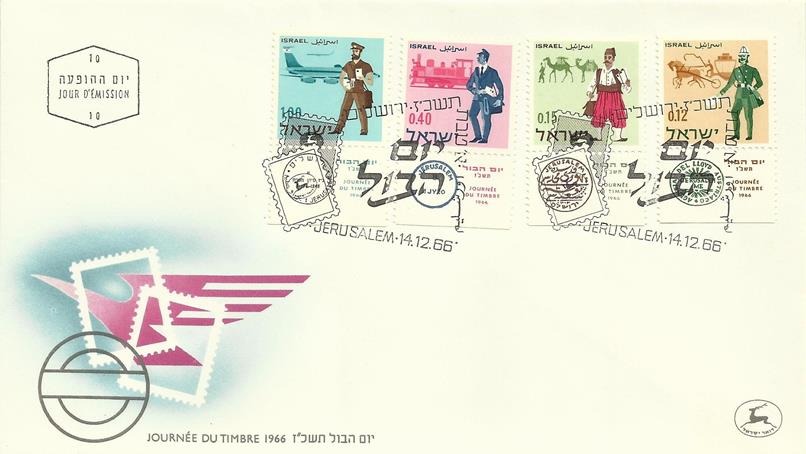
FDC: #329-32PP

Scott: #C39P
Issued: 0.03.1968
Inside #C39: Pseudo Stamp

FDC: #C39PP

Scott: #521aPP
Issued: 03.05.1973
Israel’s Declaration of Independence
Inside #521a: Pseudo Stamp


Scott: #530-1PP
Issued: 19.12.1973
Inside #530-1: Pseudo Stamp

FDC: #530-1PP



Scott: #532-4P
Issued: 25.03.1974
(postponed
from Dec. 1973)
 Inside #532:
Israel #7P..
Inside #532:
Israel #7P..
 Inside #533:
Israel #8P..
Inside #533:
Israel #8P..
 Inside #534:
Israel #9P..
Inside #534:
Israel #9P..
International stamp
exhibition
Does
not every collector of Israel's stamps set his heart on obtaining the three top
values of the Doar Ivri set
the 250, 500 and 1000 in.? Now, twenty-five years later, the Israel Post Office
has decided to help the collector realize his desire by reissuing the three
stamps, albeit in the form of special miniature sheets in honour
of "Jerusalem 73".
Just
as the original Doar Ivri
stamps renewed an ancient Jewish tradition and were devoted to ancient Hebrew
coins, symbols of the independent Jewish State that existed two thousand years
ago, so will these three miniature sheets issued to commemorate the second
International Stamp Exhibition to be held in Israel provide the link with
Israel's first stamps.
It
is interesting to note that the three coins from the second, third, and fourth
years of the country's independence bear a common inscription "Jerusalem
the Holy". The three silver shekels show on one side a temple goblet
(which is also depicted among the temple vessels on the Arch of Titus) and on
the other, three pomegranates - the symbol of fertility. The silver shekel is
the most famous of all Jewish coins -it gives expression to the concept first
put forward by our ancient wise men and which is no less valid today, that
economic independence - as symbolised by the minting
of a national currency - must march in step with political freedom. A
surprising feature of the coins is that the inscription is written in the old
Hebrew script in spite of the fact that at the time of their minting this
script had already given place to the square letters used to this very day.
This fact demonstrates that consciousness of tradition beating in the hearts of
our fighting forefathers who sought to "renew our days as of old" as
they battled the Roman oppressor.
The
history books can tell us nothing about the conditions under which the coins of
the Great Jewish Revolt were minted. Fortunately, however, evidence has been
preserved of the circumstances surrounding the preparation and printing of
Israel's first stamps in 1948 - the haste and secrecy connected with the
preparation of the designs by the artist Otte Wallish; the colour trials of the
eight stamps produced on the "Haaretz"
press in Tel Aviv; the collecting of a sufficient stock of paper obtained from
all manner of unconventional sources, the setting- up of the printing press in
the Kirya and the conspiratorial beginnings of the
printing of the stamps even before the termination of the British Mandate.
A
not unimportant factor which delayed the printing of the first stamps was the
fact that the Jewish national leadership had not yet decided on a name for the
nascent Jewish State - the stamps therefore bear the non-commital
inscription "Doar Ivri"
(Hebrew Post).
Since
those days, millions upon millions of stamps proudly inscribed
"Israel" have come off the printing presses but our very first stamps
which do not bear this name will always have their special place in philatelic
history and in the heart of every collector.
Jewish National Fund Stamps

Issued: 1974P
Jewish National Fund Stamps Overprinted
Souvenir Sheet Dedicated to Jerusalem
73' Exhibition
 Inside #???: Jewish
National Fund Stamp 1946P
Inside #???: Jewish
National Fund Stamp 1946P
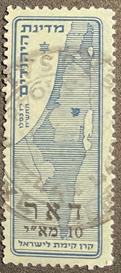 Inside #???: Jewish
National Fund Stamp 1948P
Inside #???: Jewish
National Fund Stamp 1948P
 Inside #???: Jewish
National Fund Stamp 1944P
Inside #???: Jewish
National Fund Stamp 1944P
 Inside #???: Jewish
National Fund Stamp 1909P
Inside #???: Jewish
National Fund Stamp 1909P
Towards
the end of the thirty years of British Mandate rule, on 13 April 1948, the
Mandatory Postal Department issued instructions regarding the closure of the 15
post offices and postal agencies and the cessation of all their services
between April and 5 May. The leadership of the settlement decided to act
quickly to prevent the shutdown of postal and communication services to the
Jewish settlement, which on the eve of the establishment of the state numbered
about 650,000 people.
The
period of the "Administration of the People" (leadership of the Yishuv), which was a period of transition between the
Mandatory postal services and those of the State of Israel that was about to be
established, began on May 2 and ended on May 14. During those two weeks, all
the post offices used "People's Administration" stamps, which were in
fact issued by the Jewish National Fund in addition to a car print of the word
"mail" in various forms. At that time, the settlement's ransom labels
and mandate stamps were also allowed to be used.
Two
weeks before the end of the mandate, the People's Administration launched an
action plan, the main ones being announcements to the Jewish public and postal
workers about the intention to continue the postal arrangements in the format
that was customary until then, inserting JNF stamps for temporary use and
recognizing them as postage stamps for everything. "People's Administration"
in the center of the stamp, and the name of the settlement on the margins.
This
activity of the People's Administration took place on a regular basis in most
parts of the country, and was reflected in the operation of 80 post offices,
which in fact formed the basis for the intended appearance of "Doar Ivri" stamps and the
establishment of the State of Israel.
The
military struggle for the Hebrew state began even before the declaration of its
independence. Remote areas were subject to Arab attacks and contact with many
localities was severed and took place by air or through military convoys.
Under
the leadership of the People's Administration, the local authorities decided on
postal relations with besieged localities - Jerusalem, Safed and Nahariya - while issuing stamps and local postage stamps. A
local stamp was also issued in Rishon Lezion, even though the city was not besieged.
The
People's Administration "in these circumstances endeavored to provide
postal services to the Jewish population," which at that time numbered
about 650,000 people. And these are the main steps she took: On April 25 and
27, 1848, notices were issued to the public and instructions to the postal
officials regarding the intention to continue providing postal services through
Jewish workers using the Jewish National Fund stamps and special stamps. The
tariffs and postal laws of the British Mandate will remain in force. On May 9,
an announcement was made to the public that the first Hebrew stamps and seals
would appear on May 16.
With
the declaration of the state on May 14, the period of "People's
Administration" came to an end.

Scott: #601P
Issued: 25.4.1976
NETANYA '76
Inside #601: Pseudo Stamps
Netanya's
origins can be traced back to the year 1928 when a group of young people, the
children of settlers from the Galilee, decided to establish a group of
settlements along the coastal plain which would be devoted to citriculture. Their first step was to set up an urbo-agricultural settlement near the Arab. village of Urn Haled. The bloody disturbances which broke
out just at that time, led them to have second thoughts, and in view of the
political and security situation, they decided to modify the original plan and
set up a purely urban settlement. Plans were drawn up for the founding of a
town, and in 1936 the -first master plan was completed.
This
master plan was based on an area of 10,000 dunams,
comprising for the most part agricultural land which was already planted with
citrus groves and taking in a narrow strip of sandy soil along the coast.
The
influx of immigrants from Europe after the second world war
and the transfer of the diamond industry from the Netherlands, added an
industrial dimension to Netanya and steps were taken to enlarge the municipal
area, at first to the east, by erecting an industrial park. Following the
establishment of the State, the city expanded southwards at a pace which
rapidly doubled and then trebled its original size.
Netanya
has been blessed by nature with a delightful beach and the town quickly
developed into an internationally-known holiday resort. The first holidaymakers
to discover Netanya were the local Israeli population-particularly the
Jerusalemites-but it was not long before Netanya's fame spread overseas,
particularly to the countries of northern Europe whose inhabitants return year
after year to spend part of the winter months away from their own harsh
climate. As a result. Netanya developed into an all-the-year-round holiday
resort and numerous hotels sprang up, mostly designed to cater to the tourist
of average means. These were later complemented by several first-class luxury
hotels. All manner of business enterprises, large and small, were founded in
Netanya including such industrial branches as rubber, textiles, dyeing, metal
and welding, pharmaceuticals, food and drink, etc. and a second industrial park
is currently being developed to provide a fitting home for the diamond industry
which made its first home in Netanya.
Plans
have been drawn-up to establish a combined residential, commercial and
administrative centre to the south of the city. This centre will reflect the
importance of Netanya which has became the regional centre for the whole Sharon area. The stretch of land
adjacent to the seashore will be converted into a broad strip of public parks
in which will be sited hotels and entertainment facilities for tourists and
inhabitants alike. Generous areas have been set aside for regional services
such as medical and educational centres, municipal
offices, museums, etc. There will also be exhibition grounds and a municipal
sports arena capable of hosting national events. This southern area terminates an the far side of Nahal Poleg in
the northern section of the planned National Park which will take in the
Wingate Institute for Physical Education.
Special
attention has been paid to the development of Netanyas
beaches and a series of breakwaters have been constructed which protect the
cliffs from erosion and have created a wide expanse of beaches for safe,
all-the-year-round bathing in the waters of the Mediterranean. There arc also plans far a marina to
accommodate small boats and this will give further encouragement to the
development of sailing and boating along the length of Israel's Mediterranean
coastline.
Netanya
today boasts a population of some 100.000 and plays an Important
role in absorbing new immigrants. The town is, in fact, one of the major centres of immigration from the prosperous and
under-developed countries alike. There is a special magic about Netanya which
attracts both immigrants and investors and convinces them that there can be no
better place in which to make their home.

Haifa 1980 - National Stamps
Exhibition
Inside: Pseudo Stamps

Scott: #830aP
Issued: 5.10.1982
Inside #830a: Pseudo Stamp
Beer
Sheva is mentioned in the Bible as the place where
Abraham made a covenant with Abimelech, king of Philistia following a dispute
between their servants over the rights to a well in the area: "And Abraham
took sheep and oxen, and gave them to Abimelech, and they two made a
covenant..., wherefore that place was called Beer Sheva,
because there they swore, both of them.... and Abraham planted a tamarisk tree
in Beer Sheva and called there on the name of the
Lord, the Everlasting God." (Genesis XXI: 27-33)
The
planting of the tamarisk tree marks the transition from the life of a nomad to
that of a tiller of the soil, living permanently in the shade of the tamarisk,
while calling upon the Lord as "God Everlasting" marks Beer Sheva as the cradle of monotheism.
Beer
Sheva was blessed with a supply of permanent wells;
was situated at an important crossroad and was strategically important even in
ancient times. During Biblical times Beer Sheva was
the southernmost point of the Land of Israel, marking the limit of the
cultivated area beyond which were to be found only nomadic tribes.
The
beginnings of modern Beer Sheva go back to the end of
the 19th century when the Turkish authorities set up an administrative center
on the site of the water wells. They built the first four buildings -
government house; a mosque; a regional school and the governor's residence.
Among the first settlers of Beer Sheva were to be
found a number of Jews who were particularly active in commerce and a Jewish
"mukhtar" was appointed alongside the
Moslem and Christian mukhtars.
In
the year 1906 two Jewish families set up a flour mill in the town, the first
mill in the desert apart from those in Gaza and Hevron.
Within a short time, the site became the center of activity for the local
Jewish community and a synagogue and mikve (Jewish
ritual bath) were built to serve the 100 Jews living in the town.
During
the first World War, Beer Sheva
was an important military center which, at the same time became of increasing
Jewish importance. The Jewish community was reinforced by the addition of
Jewish soldiers stationed there and by laborers and craftsmen brought in to
carry out vital construction projects such as the Turkish bridge over the Beer Sheva wadi and the railway
bridges along the Sinai railway line.
The
1929 disturbances put an end to the Jewish community, and apart from one or two
government clerks, not a Jew was to be found in the town until its liberation
in the War of Independence.
With
the establishment of the Jewish State, Beer Sheva was
designated the capital of the south, the base from which the bare desert would
be converted into a flourishing area.
One
thing above all typifies Beer Sheva - its status as
an immigrant town. The first immigrants to arrive were the refugees from the
Cyprus detention camps, in 1949. They came to a deserted town and settled down
alongside the demobilized soldiers who chose to set up home in this deserted
place.
In
February 1950 the Military Governor transferred responsibility for the town to
a Town Council and in the same year immigrants from the four corners of the
earth began to reach Beer Sheva. In the beginning,
they were housed in transit camps - in tents and shacks which were at the mercy
of the sandstorms and the burning desert wind. Gradually houses were
constructed, workshops and factories established, an educational and cultural
infrastructure created as each succeeding wave of immigration was absorbed with
the help of its predecessors.
Today,
Beer Sheva numbers some 1 30,000 souls and the town
serves as an important economic center for the Dead Sea works of Sedom, the chemical plants of Rotem, the modern chemical
complex of Ramat Hovev and the atomic energy research
center near Dimona. The educational infrastructure
ranges from kindergartens for 3-year olds, through elementary, vocational,
secondary and technical schools to a teachers' training college and a school of
physical education. The town boasts a University Hospital and Medical School
and above all, the Ben-Gurion University. The links between Beer Sheva and the surrounding development towns are very close
and the settlers of the Negev enjoy cultural events such as the theatre, music
and art, but above all, Beer Sheva continues to play
a leading role in absorbing new immigrants and integrating the varied
communities.

Scott: #942P
Issued: 22.7.1986
AMERIPEX '86
Inside #942 (In margin): Emblem




Scott: #951PP
Issued: 19.10.1986
NETANYA '86
Inside #951 (In margin): Pseudo Stamp
Ten years after the National Stamp
Exhibition, "Netanya 76", another such exhibition - "Netanya
86" is to be organised by the Netanya Philatelic
Society. The show - the 13th in the series of National Philatelic Exhibitions -
will be held on the occasion of the 50th Anniversary
of organised philately in Netanya.
It started in 1936 when a number of
stamp-lover immigrants from Germany decided to meet and create a
"Collectors Club" where stamps could be exchanged. Later, in the
1940s and, after that, during the period leading up to the establishment of the
State, interest in philately developed among the town's inhabitants.
When, on April 25th, 1948, during the
period of "Minhelet Ha'am",
the British Mandate authorities instructed all post office employees in the
country to discontinue postal services to the public, the Jewish postal workers
accepted the ruling of the Jewish Provisional Government and remained at their
jobs. At all the small provincial post offices, Jewish National Fund labels,
with the word "DOAR" (Post) printed on them, were used. Rubber hand-stamps
bearing the Hebrew words "MINHELET HA'AM" (the country's provisional
administration) and the name of the locality replaced the chancellors that had
been withdrawn. (The large cities, Jerusalem, Tel Aviv, Yafo and Haifa were
allowed to carry on until May 5th, 1948).
Philatelists all over the country
hurried to have their letters cancelled - letters that were to be sent off as
well as those which were meant to be mementos of the period when the first
Jewish postal service - "after 2000 years" - was inaugurated. Immediately
after the establishment of the State on May 16th, 1948, when the first regular
stamp series could be bought at post office counters, the citizens of Netanya
hastened to buy those cherished symbols of independence. Since then, philatelic
activity in the town has never ceased.
By the combined efforts of the Netanya
philatelists and with the assistance of the Ministry of Communications, a
Collectors' Club for the town's stamp lovers was founded in 1976, the third
such club in the country, after Tel Aviv and Haifa.
Nowadays, the Philatelic Society of
Netanya is-proud to count among its members a number of young philatelists who
have exhibited collections in Israel and other countries, some of them having
earned fine prizes. At "Netanya 86" the participation of young
collectors, some of whom will be showing their collection for the first time,
will be emphasized. There must be no "generation gap" between
philatelists. The map of the Holy Land by Gerard de Jode
(Judaeus) of Antwerp, dating from 1578, is a fine
example of 16th-century cartography. Like most contemporary maps it mainly
shows places mentioned in the Holy Scriptures, but also some more recent names.
A view of "modern" Jerusalem is incorporated. The map is directed
towards the North-West, unlike the truly "oriented" mediaeval maps
pointing to the East or modern maps directed towards the North. It was not yet
based on survey measurements, a fact which is reflected by the indented
coastline of the Mediterranean Sea and the shape of the Dead Sea. A note in the
lower margin states that the map is based on the work of Tilemann
Stelle.

Scott: #960P
Issued: 24.2.1987
Biblical birds II Owls
Inside #960 (In margin): Emblem of

Scott: #963P
Issued: 16.4.1987
 Inside #963:
Inside #963:
The
National Stamp Exhibition "Haifa 87" is being held on the occasion of
the 40th anniversary of the historic UN resolution of November 29th, 1947, on
the partition of Palestine, which was the basis for the founding of the State
of Israel, on May 14th, 1948.
The
Haifa Philatelic Society is hosting the Exhibition, which is under the
patronage of the Minister of Communications, the Mayor of Haifa and the Israel
Stamp Collectors' Federation, during the week of Pessah
(April 1987).
The
Society was established in 1938. It is the most senior of the Philatelic
Societies in Israel and has about 50 active members who meet regularly twice a
week. The Society strives to widen the knowledge about philately by organising various activities among its members and
collectors of all ages.
"HAIFA
87" is the fourth stamp exhibition held by tIie
Haifa Philatelic Society. The others were TABA (1952), TABAI (1964) and HAIFA
80(1980). Each one of the these exhibitions was of the
highest standard and enjoyed great popularity.
The
Souvenir Sheet which is being issued to mark "HAIFA 87" depicts one
of the lithographs by David Roberts HA, which shows a view of Haifa Bay seen
from the Kishon Estuary about 150 years ago.
The
Souvenir Sheet also contains an Israel postage stamp which was issued in 1952;
it was designed by the late Otte Wallish.
This
stamp, too, shows the bay of Haifa and Mt. Carmel.

Scott: #978P
Issued: 24.11.1987
Exploration of the Holy Land, 19th cent
Inside #978 (In margin): Emblem
The
souvenir sheet depicts the map of Jordan River and Dead Sea.
There
is an emblem of the National Stamp Exhibition in Jerusalem.
In
the second half of the 19th century, the river Jordan, its sources, and the
Dead Sea were still terra incognita. Although there is evidence of explorers
who had rediscovered this region in previous generations, the unknown far
exceeded the known.
The
majority of visitors to the Jordan river were pilgrims
who went down from Jerusalem to be baptised in its
waters. With the rediscovery of the Holy Land in the 19th century, the first travellers and explorers turned their attention to the
unknown areas of the land and made their way along its hypaths.
The
pioneer explorer of the Jordan and Dead Sea basins at that time (1835) was a
25-year old Irishman, Christopher Costigan who
brought his boat to the harbour of Akko (Acre) and
took it overland to Tiberias. He tried to row in the
Jordan as far as Bet Shean and from there had the
boat carried on horseback to Jericho. For eight days he travelled the Dead Sea
and got as far as the "tongue", when the excessive heat forced him to
return to the northern shores of the Dead Sea, together with his Maltese
assistant. Thirst compelled them to drink the hitter water of the Dead Sea. The
Maltese reached Jericho, having left Costigan, who
had contracted fever, on the sea-shore. He was later taken to Jerusalem, where
he died and was buried on Mount Zion.
Twelve
years later, in 1847, a British lieutenant, Thomas Howard Molyneux,
came to discover the secrets of the Jordan and the depths of the Dead Sea. He
arrived at Akko with three British friends and they transported their boat to Tiberias by camel and horse. They were joined by two local
servants. Molyneux also tried to brave the Jordan
falls but, having failed, followed its banks either having his boat carried by
camels or rowing. After many hardships and clashes with unfriendly Bedouins,
they reached the Dead Sea and sailed for two days until Molyneux
came down with malaria. He died later aboard a ship that was taking him from
Jaffa to Beirut.
One
year later, in 1848, an expedition led by an American naval lieutenant, William
Francis Lynch, came to explore the Jordan and the Dead Sea. He was accompanied
by 13 men in two boats, one of iron and the other of copper; they came ashore
at Haifa, where they were joined by four others. Their boats were carried on
camelback through the lower Galilee to Tiberias. In a
joint expedition of reconnaissance parties on land together with boats sailing
the river, they reached the Dead Sea. Lynch's expedition charted maps of the
Jordan and the Dead Sea.
During
1868-1869, John MacGregor, a Scotsman, sailed his canoe through the Suez Canal,
along the Nile, the rivers of Damascus, the sources of the Jordan, Lake Hula,
the Sea of Galilee and the Kishon river.
He used a canoe because only such a boat could sail through the swamps and
marshes. In the Hula valley, he was taken prisoner by Bedouins but managed to
escape thanks to his courage and resourcefulness. He mapped Lake Hula and the
Sea of Galilee. His canoe "Rob Roy", recently discovered in England,
has been brought to the Eretz Israel Museum in Tel
Aviv.

Scott: #986P
Issued: 19.04.1988
Independence 40 Stamp Exhibition,
Jerusalem
Inside #986 (on Label): Emblem of the
National Stamp Exhibition in Jerusalem.

As
part of Israel's 40th anniversary celebrations, Jerusalem will play host to the
National Stamp Exhibition, "INDEPENDENCE 40", which is to be held in
the spacious halls of Binyanei Ha'uma
Convention Centre, during April 1988.
Although
it has been organised as a National Stamp Exhibition,
about 90 well-known collectors from other countries are sending exhibits for
the International Section, with collections on the subject "The Holy Land
and Levant" as well as Judaica.
The
Exhibition is under the patronage of the Minister of Communications and the
Mayor of Jerusalem. It is being organised by the
Jerusalem Philatelic Society under the auspices of the Israel Philatelic
Federation and in close co-operation with the Postal Authority, Philatelic
Service.
The
Jerusalem Philatelic Society is also celebrating a special anniversary this
year - its 50th - and can look back with pride at having successfully organised other exhibitions in Jerusalem in honour of earlier anniversaries of the State, such as
"TABIRA" (1968) "TABIR" (1978) as well as the international
one "JERUSALEM 73".
There
are to be more than thirty dealers' booths where interesting philatelic
material will be offered to collectors. The Postal Authority, Philatelic
Service will be represented prominently by a special exhibit. During
"INDEPENDENCE 40" a number of philatelic events and conventions are
to take place in Jerusalem.
As is
customary, each day of the Exhibition will be dedicated to a particular subject
for which suitable special cancellation will be prepared; sample impressions of
the cancellations are shown in the leaflet. The Exhibition is financed by the
Israel Postal Authority.
The
subject of the Souvenir Sheet and Stamp to be issued in honour
of "INDEPENDENCE 40" is 'Buildings in modern Jerusalem". They
depict the Jewish Agency Complex, the Generali Building, the Israel Museum, the
YMCA, the Hebrew University Synagogue at Givat Ram, the Jerusalem Theatre, the new project at Gilo and the house of Dr Bunhem in Rehavia quarter of
Jerusalem. Some of the buildings have been depicted on earlier Israel stamps.

Scott: #987P
Issued: 19.04.1988
Independence 40 Stamp Exhibition,
Jerusalem
Inside #987 (In margin): Emblem of the
National Stamp Exhibition in Jerusalem.

European Stamp Exhibition – Ferusalem 19.12.1995P
Non-postal Item
Inside: Pseudo Stamps

European Stamp Exhibition – Ferusalem 19.12.1995P
Non-postal Item
Inside: Pseudo Stamps



World Stamp Exhibition – Tel Aviv
13-21.5.1998O
Non-postal Item
Inside: Pseudo Stamps

Scott: #989PP
Issued: 9.6.1988
40th Anniversary Exhibition
Inside #989a:
|
|
|
|
|
Israel #245PP |
Israel
#297PP |
Israel
#120P |
|
|
|
|
|
Israel
#96PP |
Israel
#794PP |
|
|
|
|
|
|
Israel
#252PP |
Israel
#333PP |
Israel #478PP |

Scott: #1033PP
Issued: 12.10.1989
Tevel 89
- National stamp exhibition for youth philately
Inside #1033-4: Pseudo Stamp

Tevel 89 is a national stamp
exhibition for youth, with participants from around the world. The Exhibition, organised by the Israel Philatelic Association and funded
by the Israel Postal Authority, is being sponsored by the Ministry of
Communications, the Ministry of Education and Culture and the Director-General
of the Israel Postal Authority. It will take place in Bnai-Brith
House during the intermediate days of the Festival of Succot
(Tabernacles), 15-21 October 1989.
At
the Exhibition, in addition to the stamp collections, there will be sales
counter for the Philatelic Service of the Postal Authority, a post office
counter providing postal services, as well as vending stalls, etc.
Young
philatelists from the ages of 10 to 21 will exhibit at the Exhibition in the
international and national sections. There will be 310 different categories in
the Exhibition, and a very full display. A total of 120 young people will be
exhibiting.
In
the international section, there will be young philatelists representing 7
countries and the quality of the Exhibition is expected to be very high by
current international standards
The
Exhibition has a number of different purposes, but its main purpose is to
create an awareness of philately as an exciting, educational hobby, which
furthers aesthetic and moral values among the public in general, and among the
future generation in particular.

FDC: #1033P

Scott: #1034PP
Issued: 17.10.1989
1st Israeli Stamp Day
Inside #1033-4: Pseudo Stamp
It
was the idea of the German collector, Hans Von Rudoiphi,
to hold a "Stamp Day" which would take place every year on a specific
date. The idea was first used by Austrian philatelists on 1 December 1935 at a
special stamp exhibition dedicated to the Stamp Day. A month later, German
philatelists also met to celebrate a Stamp Day, and thereafter a Stamp Day was organised every year in both these countries. Later, the
idea of a "Stamp Day" was adopted by other countries and today Stamp
Days take place, in one form or another, in about 50 countries.
Stamp
collecting developed and grew in the years following the Second World War and
became a popular hobby with thousands of enthusiasts. At the same time, the
production of stamps took giant strides because of the immense technological
advances in printing and the increasing interest of painters and graphic
artists in stamp design.
However,
the war years, and the economic crisis and inflation which followed undermined
philatelist societies to the point where on the verge of chosing
down it was than that the postal authorities stepped
in to help. They had an interest in promoting philately, and in establishing
new groups of collectors, from both an economic and an educational point of
view.
In
this way began the cooperation between philatelic associations and postal
authorities, in bringing out special stamps for Stamp Days or for other
philatelic occasions, such as exhibitions, as a way of raising the funds
necessary to keep philatelic organisations going. For
this purpose, Austria put out a stamp for Stamp Day on 3 December 1949, but she
was preceded by Spain who put out the first ever "Stamp Day" stamp on
12 October 1944, and by Hungary on 21 December 1947. In 1974 West Germany
published the first stamp commemorating the 40th anniversary of the first
"Stamp Day".
With
time, the style of the annual event has changed in some places and "Stamp
Day" has been replaced by "Philately Day". Recently, countries
such as Belgium, Portugal, San Marino, the Antilles, Salvador and others have
published special stamps for their Philatelic Societies to encourage and
promote philately, and most countries also bring out stamps for national and
international stamp exhibitions.
The
first Israel "Stamp Day" will take place on 17 October this year,
during "Tevel 89", a national stamp
exhibition for youth, which will have participants from around the world and
will take place in Bnai Brith
House in Tel-Aviv from 15-21 October. The Israel Stamp Association, together
with the Postal Authority and the Philatelic Service, will continue to organise "Philatelly
Day" every year and to bring out a special stamp to mark the occasion.
On
the face of this year's stamp appears the insignia of the World Stamp
Authority, the F.l.P. (Federation Internationale
de Philatelie), which was founded in 1926 by the
philatelic societies of 7 countries: Austria, Belgium, Germany, The
Netherlands, Czechoslovakia, France and Switzerland. The Israeli Association
was accepted as a member of the organisation in 1946.
Today, there are more than 60 countries who are members of the International
Philatelic Federation. The insignia on the border is that of the Israeli
Philatelic Association.
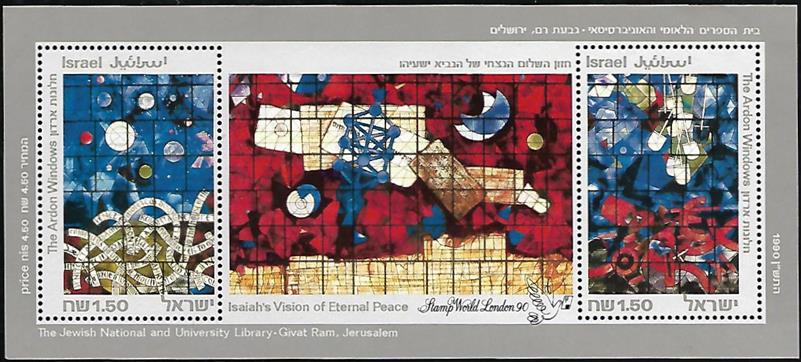
FDC: #1034P

Scott: #1041PP
Issued: 17.4.1990
Stamp World
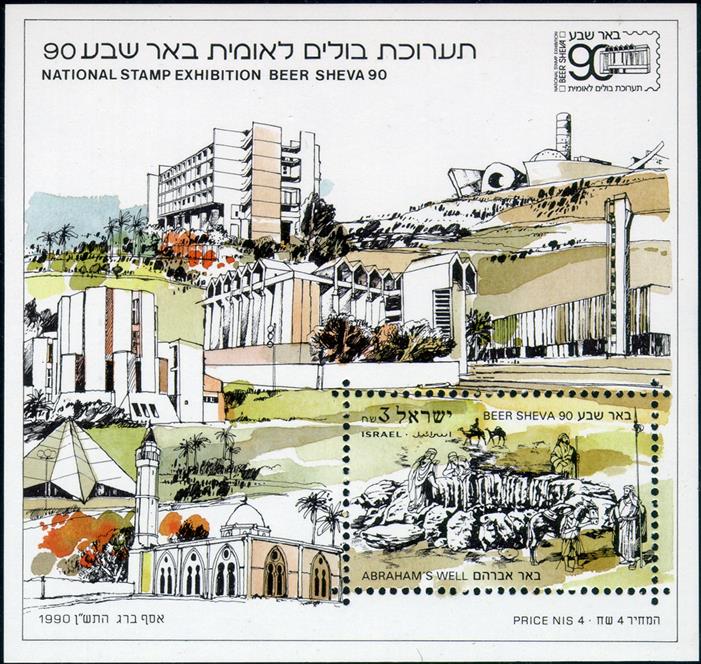
Inside #1041: Pseudo Stamp in Margin
Mordecai
Ardon is one of the great painters of Israel. During
mare than five decades he has produced a great number
of paintings of a very specific style.
The
themes of the stained glass windows which Ardon
created for the National and University Library at the Hebrew University in
Jerusalem are taken from Isaiah 2, 2-4: 'and many people shall go and say, come
ye and let us go up to the mountain of the Lord".
The
Windows can be seen as the masterpiece of this outstanding painter, as shown
both in the idea itself and in its artistic content. The close connection
between the subject of the Windows - Jerusalem - and their position in the
library, the Hall of the eternal spirit of Jewishness and Humanism, is obvious.
It was the artist himself who chose this place for his creation and it was the
place itself which gave him inspiration.
In
the left part of the Windows, one can see the roads on which the people of the
world go up to Jerusalem. On each one of these roads is written the above
quotation in different languages and letters. In the centre one can see
Jerusalem, the Holy City with the city wall as mentioned in the Isaiah scroll,
which was found among the Dead Sea Scrolls.
Above
this wall is a piece of parchment and on it another quotation from the Book of
Isaiah: "... and they shall beat their swords into plough-shares".
Next to this there are blue circles intertwined with lines - the Cabbalistic
"Tree of Spheres". Ta its left is another set at figures, a circle
within a circle, this too, from the "Book of Zohar".
In
the right part of the Windows, one can see an illustration at Isaiah's prophecy
- broken guns and ammunition beaten into plough-shares, hovering above.
The
Windows measure 16 x 6 meters and are among the largest stained glass windows
known. The artist started work on them at the end of 1980. The assembling was
carried out by the master-crattsman Charles Marc at
the "Atelier Simon" in Rheims, France. The Windows were unveiled on
April 1st, 1984, Mr. Ardan dedicating them to the
memory of his late wife Miryam. The dedication
appears in the lower left hand corner at the windows. Ardon's
works are exhibited in the important museums of the world and in many private
collections. The creation and installation of the Ardan
Windows were made possible through the initiative, generosity and unstinting
efforts of Zefira and Ephraim Ilin.

Scott: #1067PP
Issued: 4.9.1990
Inside #1067: Pseudo Stamp, Emblem
The
National Stamp Exhibition, "Beer Sheva 90",
is being held in the Yad Lebanim House in Beer Sheva from
5 - 12 October 1990, during the Festival of Sukkut.
The
Exhibition is being organised by the Beer Sheva Philatelic Association, under the auspices of the
Israel Philatelic Federation and is being funded and supported by the Israel
Postal Authority and its Philatelic Service.
The
Exhibition comprises some 450 frames: 150 of them are designed for young
people, 150 are part of the countrywide exhibition, and 150 are part of the
national Exhibition.
Computers,
offering philatelic information, will be at the disposal of the young visitors,
and in addition to this there will be a wireless station at the Exhibition for
radio hams.
As at
every stamp exhibition the Israel Postal Authority and the Philatelic Service
will run their activities and beside the displays there will also be stalls of
Israel stamp dealers.
The
last National Stamp Exhibition to be held in Beer Sheva
was in 1982. The present Exhibition continues to promote philately throughout
the Negev.
Beer
Sheva is one of the oldest cities in Israel. It had a
special importance in Biblical times, and it is from the Bible that we learn
how the town was given its name which means "the Well of the Oath".
After a quarrel over wells between the shepherds of Abraham and Avimelech, they made a pact "wherefore he called that
place Beer Sheva: because there they swore both of
them" (Genesis 21, 31).
Beer
Sheva has had its ups and downs. When John Hyrcanus conquered Edom, the city fell under the hegemony
of the Hasmonean kingdom. After the destruction of the Second Temple the town
became one of the central strongholds of the Roman border, defending the Empire
from incursions of the Nabateans. The city was abandoned during the Arab period
and remained uninhabited until the nineteenth century when the present-day city
first came into being.
At
that time the Turkish Sultan, Abed EI-Hammid II,
decided to increase his activities in the outlying areas on the southern
extremities of the Ottoman Empire. In the year 1900, he began to set up
government buildings, a Mosque and a school. Already at that time a number of
Jewish families had settled in the town and established a flour mill and were
involved in trading. During the period of the British Mandate, the development
of the town was halted and it became a small provincial town on the fringe of
the settled area of Palestine.
In
1948, the city was taken by the Negev Brigade, and since that time it has
enjoyed continual development and serves as the capital of the southern part of
the State of Israel.
On
the souvenir sheet that the Philatelic Service has put out for the Exhibition,
appear various institutions of present-day Beer Sheva,
and on the stamp itself - a sketch of Abraham's Well that was drawn according
to a copper engraving from the 17th Century. In the centre of the sheet is a
sketch of "Yad Lebanim"
House and around it, anti-clockwise, starting with the Beer Sheva
City Hall building (right, above the stamp) are: the Negev Brigade Monument
(top right); the Soroka Hospital (top left); the City
Conservatory (left); a Synagogue; and a sketch of Beer Sheva
Museum (bottom left).

Beersheba '90 – Special Souvenir Sheet
395/800
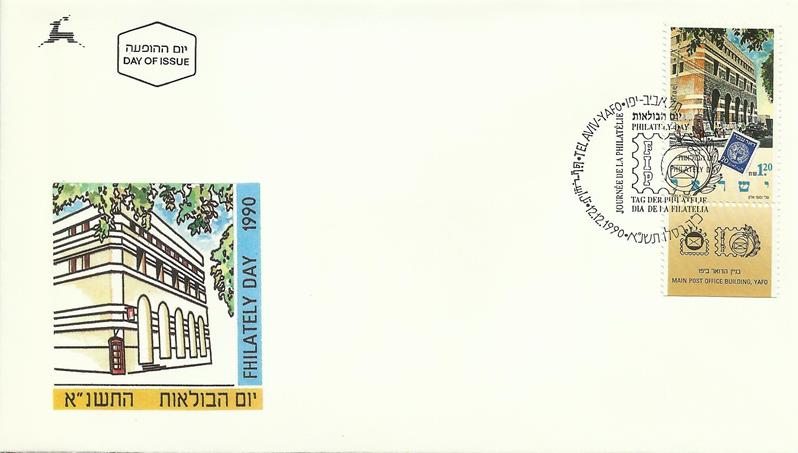
Scott: #1072PP
Issued: 12.12.1990
Philately Day
 Inside #1072:
Inside #1072:


Scott: #1074P
Issued: 19.02.1991
Special Occasions Type of 1989
Inside #1074: Pseudo Stamp


Scott: #1088P
Issued: 11.6.1991
Postal and Philatelic Museum, Tel Aviv
 Inside #1088:
Israel #5P
Inside #1088:
Israel #5P
 Inside #1088:
Palestine #70P
Inside #1088:
Palestine #70P
 Inside #1088: Turkey #133P
Inside #1088: Turkey #133P

Inside
#1088 (In margin):


Inside
#1088 (In margin): Israel #1-9P

 Inside #1088 (in
margin): Stamp of KKL - 1948 overprint "DOAR" (MAIL)
Inside #1088 (in
margin): Stamp of KKL - 1948 overprint "DOAR" (MAIL)

 Inside #1088 (in
margin): Palestine #64P
Inside #1088 (in
margin): Palestine #64P

Inside
#1088 (in margin):

Postcard
1887

Inside
#1088 (in margin): Postcard -TBI, Turkish stamp (Turkey #133)
The Postal history of Eretz Israel
Eretz Israel was
conquered by the Ottoman Turks in the 16th century. With the decline of the
Turkish Empire, and particularly in the 19th century, the number of European
inhabitants in Eretz Israel grew and the European
powers - Russia, Austria, Italy, France and Great Britain - competed with each
other to increase their influence on the Sultan's regime.
The
European powers finally signed the Capitulations Agreement with Turkey which
granted foreign nationals the right to set up their own Representative Offices
in the country. As a consequence of this Agreement there was an expansion of
the postal services and the various Offices were permitted to organize their
own overseas postal services - the Consular Post.
It
seems that the first postal cancellation effected by one of these foreign
postal services was that of the French Postal Agency in Jaffa in 1852. In 1854
the Austrians opened a Post Office in Jerusalem, to be followed by offices in
Jaffa and Haifa. Russia opened its Post Office in 1861, Germany in 1898 and
Italy in 1908. The success of these Consular Posts persuaded the Turkish
authorities to establish their own postal services, and the first Turkish Post
Office was opened in Shechem (Nablus) in 1865. The
quality of the Turkish Postal Service was very poor. The mail to most
destinations was conveyed on the backs of camels or donkeys - very little went
by carriage. On more than one occasion, the post offices ran out of stamps and
it took quite a time until new supplies were received. In spite of this, the
Turkish authorities continued to compete with the Consular Post and opened
additional post offices in Rishon Leziyyon
(1904), Rehovot and Petah Tikva
(1910), and Zichron Yaakov (1912). They even sold
stamps intended for overseas mail at half the price fixed by the Universal
Postal Union.
One
month after the outbreak of the First World War, all the Consular Post Offices
were closed down. Very little use was made of the civilian postal services
during the war, and postal connections with abroad came to a virtual
standstill.
During
the period of British, rule, first as a military occupation in 1918, and later
under a League of Nations mandate (1920-1948), the local population used the
Mandate postal services. In a very few cases, the Jews set up their own postal
services - the settlements in the Negev maintained contact with the Jewish
authorities by using pigeons and the resistance movement had its own
communications services.
In
April 1948, the British Mandate authorities planned to suspend all postal
services in the country and all the post offices were due to be closed.
However, the Minhelet Ha-Am - the State on the Way -
got to know about this closure order which would have dealt a serious blow to
the country's foreign postal communications, and all Jewish postal workers were
ordered to remain at work.
When
the British left, the post offices continued to sell the Mandate stamps for a
time. JNF labels were also used, as were the "Kofer
Ha-Yishuv" stamps which had been issued by the Hagana during the riots. The Minhelet
Ha-Am was anxious to print Hebrew stamps, but when it became apparent that
there was insufficient time for this, they authorised
the use of various JNF labels which were overprinted with the word
"DOAR" POST.
These
Minhelet Ha-Am stamps were in use for only a short
time - from the beginning of May until the day of the Declaration of the State
- two days later, the "Doar lvri"
stamps were issued. It was only in the besieged towns and settlements that
people continued to use the JNF labels until supplies of the Doar lvri stamps arrived.
Some
besieged towns even issued their own stamps as a temporary measure.
The
Postal and Philatelic Museum
On
looking at all those multifarious items which come under the heading of
"mail", we find ourselves coming into contact with, among other
things, the daily life of the people who once inhabited Eretz
Israel. Historical events, such as the break-up of the Turkish Empire, are
illustrated by the peregrinations of a letter, or by the changes in a postmark.
The establishment of the Postal and Philatelic Museum provides us, therefore,
with a window through which we can gaze upon the history of Eretz
Israel. This museum will house objects illustrating written communications
between Man and his neighbour, with particular
emphasis on the Land of Israel. On display there will be mail and stamps from
various periods including the period of Turkish rule, that of the Consular
Post, the British Mandate and the Minhelef Ha-Am.
Stamps on the theme of Judaica from all over the world and stamps from the
period of the Holocaust will also be exhibited. There will be a prominent
display of all the stamps and postmarks of the Israel Postal Service.
Explanations of the subjects portrayed on the stamps will also be provided, so
that the spectator can understand the concise "language" of the
stamp.
The
procedures involved in preparing stamps will be explained, too, and the Museum
is to have a collection of documents concerned with the planning and production
of new stamps; minutes of the Stamp Design Committee, documents from the
Ministerial Committee on Ceremonies and Symbols, etc. Printing plates, designs
and photographs which will reveal to the visitor the "secrets" of the
stamp planning and production process will also be on display.
The
museum will give expression to all aspects of postal and philatelic activity -
the printing of stamps; the uniforms of the postal couriers; postal coaches and
motor vehicles, and objects portrayed on Israel's stamps.
The
museum's objective is to become a busy institution which will not only meet the
expectations of confirmed philatelists, but will also arouse the interest of
young people and the general public. The museum library will provide a source
for the furthering and widening of research into the various aspects of Holy
Land postal history and philately.
The
museum is being built on the campus of the Tel Aviv "Eretz
Israel" Museum.
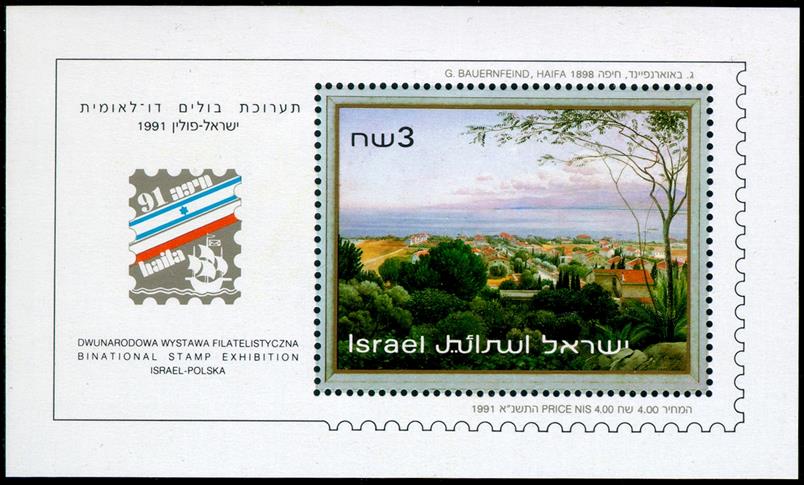

Michel # Block 43B
Imperf s/s - raise funds for the Museum
(Thanks to Lou for the scan)
 Sp
Sp
Special Issue 1991

Scott: #1094P
Scott: #1094
Issued: 27.8.1991
Haifa ’91, Israeli-Polish Philatelic
Exhibition
Inside #1094: Pseudo Stamp, Emblem

Scott: #1095P
Issued: 2.12.1991
Philately Day
 Inside #1095:
Inside #1095:

1991
was the third year that Israel issued a Philately Day stamp. The revenues from
the stamp's sales were earmarked for the Philately Promotion Foundation. The
Foundation was established by the Postal Authority in conjunction with the
Israeli Philatelic Federation in accordance with a recommendation of the
International Federation of Philately and the Universal Postal Union. The
Foundation intends to support various activities that will assist in enlarging
the numbers of people engaged in the hobby of philately, one of the most
enjoyable, cultural and varied hobbies for all ages.
The
thematic philatelist will include the Philately Day stamp with his collection
of "Stamps on Stamps" or "Coins on Stamps". A collector specialising in "The History of Israel on Stamps"
will find a special significance in the coin depicted on the five mil stamp
from the Doar lvri set.
This is a bronze coin from the First Revolt period, bearing the words
"Freedom of Zion". Through this stamp, the thematic collector can
relate the story of the First Revolt on the pages of his collection.
Moreover,
this stamp bears direct reference to the saga of the establishment of the
modern State of Israel. During the stormy months of early 1048, before a name
had finally been given for the new State, it was decided to print its first
stamps with a neutral name - "Doar Ivri" - Hebrew Post. The traditional philatelist will
certainly attempt to identify "the stamp", which is shown on this
stamp. Was it printed from the first plate or possibly from the second plate?
The first printings of the Doar Ivri
stamps were done under difficult technical and 'underground' conditions. The
results of these conditions are recognisable in the
types of paper, the printing on the tabs, the printing letters which were reset
time and time again and the different perforating machines which were used. The
five mil stamp was printed on four different types of paper, more than 40 tab
varieties can be found and there are many perforation varieties. The research
continues, bringing much enjoyment to the many Doar Ivri collectors around the world. The postal history
philatelist is interested primarily in the direct postal usages of the stamp.
He would want to include in his collection a cover bearing only a fine mil
stamp - and this is not simple, since it was principally intended for printed
matter sent abroad by sea. Furthermore, this philatelist will attempt, insofar
as possible, to expand a collection of envelopes bearing this stamp. He will
also try to find covers with postmarks dated as close as possible to 16th May
1948, the day on which 80 post offices of the new State began operating, each
having its own distinct postmark.
On
16th May 1948 the Doar Ivri
stamps did not reach besieged cities such as Jerusalem and Nahariya.
The philatelist will try to locate the first envelopes bearing the Doar Ivri stamp that were sent
from these cities.
The
1991 Philately Day stamp thus unfurls the story of our distant past, the First
Revolt, and our recent past, the establishment of the State of Israel. The
stamp also demonstrates the development of a special branch of art - the art of
stamp design. The collage technique and selection of the pastel colours used as background for the original stamp create an
attractive and unique combination of the styles of the different years.

Scott: #1129P
Issued: 8.12.1992
Philately Day
Inside #1129 (on Label): Emblem with
Pseudo Stamp
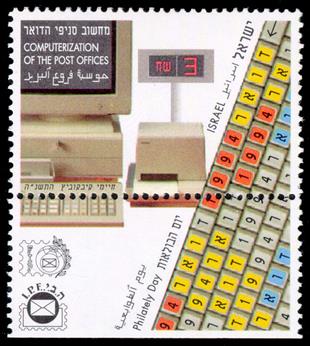
Scott: #1152 - See after #1254

Scott: #1178P
Issued: 21.8.1993
Telafila
’93, Israel-Romania Philatelic Exhibition

Inside #1178 (in margin): Pseudo Stamp
in logo

FDC: #????P
Issued: 22.8.1993
Telafila
’93, Israel-Romania Philatelic Exhibition – Opening day

Scott: #1220P
Issued: 27.11.1994
Computerization of Post Offices
Inside #1220 (on Label): Emblem with
Pseudo Stamp
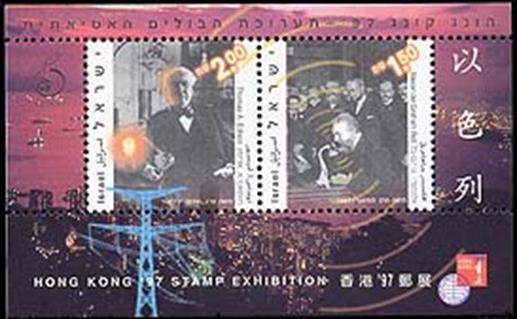
Scott: #1254P
Issued: 16.12.1995
3000th Anniversary to Jerusalem

Inside #1178 (in margin): Pseudo Stamp
in logo

Scott: #1152P
Issued: 17.04.1996
China ’96, 9th Asian Intl. Philatelic
Exhibition
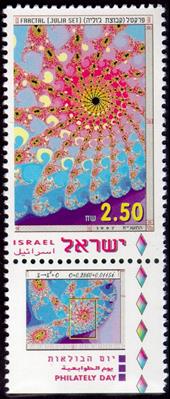
Inside #1152 (in margin): Pseudo Stamp
in logo

Scott: #1196P
Issued: 13.2.1996
Hong Kong ’97
Inside #1196 (in margin): Pseudo Stamp
in logo
The Souvenir
Sheet, issued in honour of the 150
year anniversary of the birth of Thomas Alva Edison and Alexander Graham
Bell, is dedicated to the Asian International Stamp Exhibition to be held in
Hong Kong in 1997.
The
stamp on the right hand side shows Alexander Graham Bell dedicating the New
York - Chicago telephone line in 1892. The stamp on the left hand side shows
Thomas Alva Edison in his laboratory with a light bulb.
The
background of the sheet shows a photograph of Hong Kong by night (photo by Gidi Marinsky), together with an
electric pole, developed in Israel.
The
lower right corner of the sheet shows the logo of the Hong Kong '97 Exhibition.
The upper left corner of the sheet shows the logo of the Israel World Stamp
Exhibition '98.

Scott: #1306P
Issued: 29.05.1997
100 years since the discovery of the
Cairo Geniza / 50 years since the discovery of the
Dead Sea scrolls

Inside #1306 (in margin): Emblem with
Pseudo Stamp

Scott: #1324P
Issued: 23.12.1997
Philately Day
Inside #1324 (on Label): Emblem with
Pseudo Stamp


Scott: #1328P
Issued: 17.02.1998
War of Independence 1947-9

Inside #1328 (in margin): Emblem with
Pseudo Stamp

Scott: #1335P
Issued: 13.05.1998
Children’s Pets

Inside #1335 (on Labels): Emblem with
Pseudo Stamp
No.
1335 contains diagonal perforations so that lower left corner of each stamp can
be removed leaving denominated portion in shape of a pentagon.

Scott: #1336a-cP
Issued: 13.5.1998
Postal and Philatelic Museum
Inside #1336b: Pseudo Stamp

Scott: #1336P
Inside #1336 (In Margin): An envelope
from 1910 with KKL (Jewish National Fund) Label Used as Postage Stamp

On
the left is the postage stamp issued in
The
stamp was issued at the initiative of Isaac Goldanhiars, rising from Romania.
Goldanhiars, together with the Austrian post office manager in Jaffa
wanted to establish a new post office in Petach Tikva. Goldanhiars demanded
that the the Austrian Consulate will issue a uniqe stamp for the new
post office, which will serve for international mail and domestic
mail. At the end of 1908 the Austrian Consulate issued this stamp,
designed by an unknown artist.
Compared
with the design technology of the time, the stamp design is very colorful. His
head flew Petah Tikva city name in Hebrew letters illuminating yellow, the
price premium was shown at the bottom - 14 Farrah (an ancient coin that served
as the Ottoman Empire).

The
second stamps is a KKL stamp of Max Nordau (KKL is the Jewish National Fund). From
1902 until the late 1940s, KKL sold KKL stamps to raise money. For a brief
period in the beging of the 20th centery Austrian post in Israel consider them
as local stamps and for a brief period in May 1948, KKL stamps were used as postage stamps during the transition from
Palestine to Israel.

The
original envelope include an Austrian stamp as well and was send to Vienna,
November 12, 1910. The letter was sent through the
Austrian post office in Petah Tikva.
All
stamped with the bilingual stamp "Petach Tikva / Austrian Post" with
a large Star of David in the center.
On
the back is a stamp of arrival in Vienna, November 1910. http://www.collect.co.il/content.aspx?id=421

Scott: #1339aP
Issued: 3.05.1998
Aircraft Used in War of Independence
1948

Inside #1339a (on Labels): Emblem with
Pseudo Stamp
No. 1339a was issued in sheets
containing 2 strips printed tete beche
separated by strip of three labels.

Scott: #1340P
Issued: 13.05.1998
Mosaic of a Young Woman, Zippori

Inside #1340 (in margin): Emblem with
Pseudo Stamp

Scott: #1341P
Issued: 13.05.1998
King Solomon’s Temple

Inside #1341 (in margin): Emblem with
Pseudo Stamp

Scott: #1379P
Issued: 1.9.1999
Philately Day – Stamps Collecting
 Inside
#1379:
Inside
#1379:
Israel's
entry into the philatelic world involved feverish preparations which began
clandestinely a few weeks before the State was declared. In April 1948 the
British, about to relinquish the Mandate over Eretz
Israel, severed all postal services. The Jewish authorities began hurried
preparations for printing stamps for the nascent State. The problems seemed
overwhelming. Gummed paper was all but nonexistent. Where were the suitable
printing presses and perforating machines to be found? How were the stamps to
be inscribed? There was as yet no decision, as to the name of the new State.
Was it to be Judah, Eretz Israel or Israel?
Eventually a letter press was found and sufficient
paper of a variety of shades and thicknesses was collected.
Less
than forty-eight hours after the declaration of the Independent State of Israel
which took place on Friday, May 14, 1948, enemy planes had launched their first
attack and Israel had issued her first postage stamps - Israel's first stamps,
the now famous and coveted Doar Ivri
(Hebrew Post) series, were available at all post offices in the country.
Since
1948 Israel has issued many stamps: these include regular (definitive) issues,
airmails and commemoratives. Some of the earlier stamps have already attained
the status of classics and are prized by collectors throughout the world.
The
stamp issued this year to mark Philately Day shows an illustration by artist
Michel Kichka portraying a "Philately
Family" with a stamp of the "Doar Ivri" series.On the stamp
tab are the emblem of the Israel Philatelic Federation and the emblem of the
F.I.P. (Federation International de Philatelic), of which Israel is a member.


Scott: #1439P
Issued: 18.3.2001
Flowers

Inside #1439: Pseudo Stamp in logo

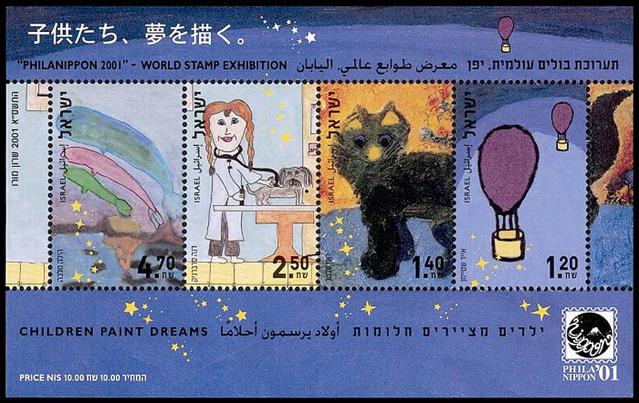
Scott: #1440P
Issued: 18.3.2001
Jerusalem 2001 – Multinational Exhibition

Inside #1440: Pseudo Stamp in logo

Scott: #1445P
Issued: 23.5.2001
Belgica
2001 Intl. Stamp Exhibition, Brussels

Inside #1445: Pseudo Stamp in logo

Scott: #1451P
Issued: 17.7.2001
Phila
Nippon 2001, Japan

Inside #1451: Pseudo Stamp in logo

Scott: #1458P.
Issued: 11.12.2001
Philately Day – The First Israeli
Astronaut
Inside #1458: Pseudo Stamp on Tab


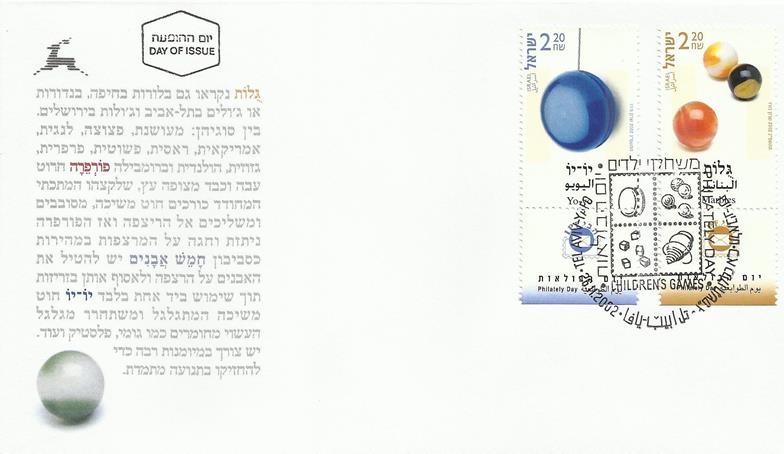


Scott: #1497-1500P
Issued: 26.11.2002
Philately Day – Children’s Games
Inside #????-?:
Pseudo Stamp on Tab



Scott: #????-?
Issued: 1.7.2003
My stamp
Inside #????-?:
Pseudo Stamp on Tab




Scott: #1546a-dP.
Issued: 9.12.2003
Philately Day - Children on Wheels
Inside #1546a-d: Pseudo Stamp on Tab

Scott: #1546P.

Special sheetP

EnvelopeP
Philately Day 2003
Issued: 23.12.2003

Issued: 1.7.2004
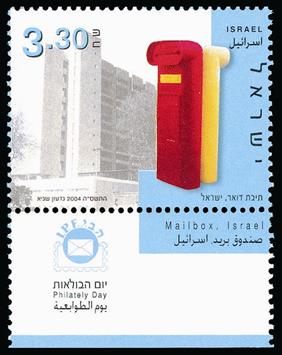

Scott: #1580
Issued: 14.12.2004
Design your Stamp
Inside #1580: Pseudo Stamp on Tab
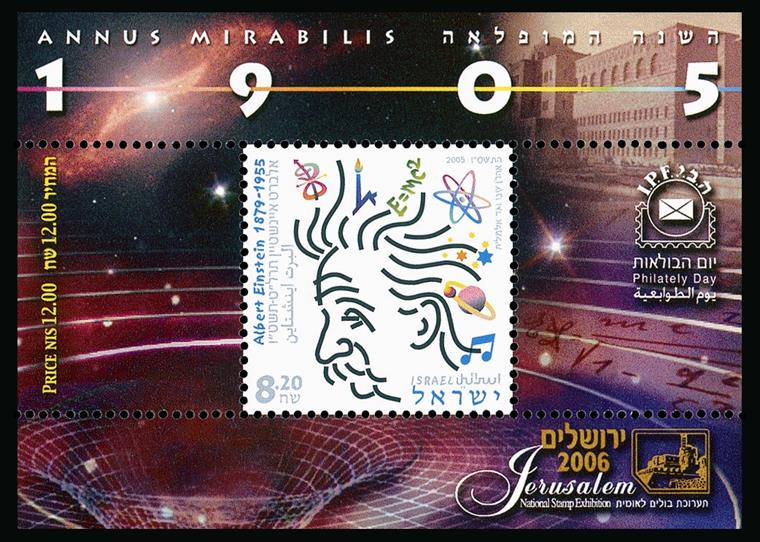

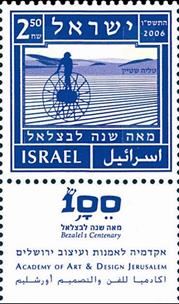

Scott: #1582-4
Issued: 14.12.2004
Philately Day - Mailboxes
Inside #1582-4: Pseudo Stamp on Tab

Colorful
decorated mailboxes could be found in Jerusalem and Jaffa at the beginning of
the 20th century. These were the first mailboxes of Eretz
Israel that were installed by the consular post
offices, which were in operation since the second half of the 19th century.
Foreign
consular representation in Eretz Israel was part of
the Capitulations agreements - rights granted to foreign
citizens, including Jews, who lived under the Ottoman rule. Those rights
enabled the use of foreign postal services.
Until
then, the Ottoman postal services operated by means of couriers between
Jerusalem and Beirut. It was only when the first steam ships docked in the
ports of Eretz Israel, and shipping companies
introduced the first overseas postal services, that France, Austria, Germany,
Russia and Italy offered independent postal services in Eretz
Israel.
The
official visit to Eretz Israel of the German Kaiser,
William 11 and his wife Augusta Victoria, in the autumn of 1898, marked the
beginning of the German postal services in the country.
The
German postal activities involved precise organization paying attention to
improved service to the customer. In order to fulfill this objective the
Germans installed the first mailboxes in Eretz
Israel. The mailboxes were blue and decorated with a gold colored letter slot.
They were placed outside post offices, businesses and at collection points
along the carriage route between Jaffa and Jerusalem.
In
1902 the Austrian postal services followed the Germans and placed yellow
mailboxes around the country and postmen began to deliver mail. The Turkish
post also had mailboxes, which were simpler in a reddish brown color.
With
the outbreak of the First World War the consular offices under the Ottoman
administration were closed and on 30 September 1914 foreign postal services in Eretz Israel ceased.
In
December 1914 Eretz Israel was taken over by the
British thus ending four hundred years of Turkish rule in the country. During
the British Mandate impressive post offices were built in Jerusalem, Yaffo and in other cities. The mail was transported by
train and other vehicles within Eretz Israel and by
land, sea and air to other countries.
Mailboxes
during the British Mandate were exact copies of the mailboxes used in Britain -
bright red in color and decorated with the monarchy's emblem.
Since
the establishment of the state, the design of the mailboxes has been changed
but they are always red.
When
the Israel Postal Authority was established, yellow mailboxes were placed next
to the red ones in order to facilitate the sorting process. The yellow
mailboxes were for local mail only and therefore eliminated part of the sorting.
Sorting methods however have now been greatly improved so that since the second
half of 2004 the yellow mailboxes are no longer in use.
A
display of historic and modem mailboxes are part of the permanent exhibit at
the Israel Postal and Philatelic Museum, which is situated in the Eretz Israel Museum, Tel Aviv.

Scott: #1620
Issued: 27.12.2005
Philately Day
Inside #1620 (In margin): Pseudo Stamp



Scott: #1656 (B)
Issued: 12.09.2005
100th Anniversary of Bezalel
Academy of Arts and Design
![[Tiberias, type G]](Israel_image341.jpg) Inside #1656: Palestine #78P
Inside #1656: Palestine #78P
The
Bezalel Academy of Arts and Design Centennial
In
1903, Prof. Boris Schatz (1866-1932), one of the founders of the Royal Academy
of Art in Sofia, Bulgaria, inspired Dr. Theodor Herzl, the visionary leader of
the Zionist movement, to establish a school of art and craft in Eretz Israel. The
Seventh Zionist Congress, convening in 1905, moved to establish
"Bezalel," and in 1906 the institution, located in Jerusalem, was
inaugurated by Prof. Schatz. A distinguished artist and sculptor in his
own right, Boris Schatz directed Bezalel until 1929.
The
institution was named for the biblical Bezalel, son of Uri, son of Hur, builder of the Ark of the Covenant and its vessels,
and the first artisan mentioned in the Bible (Exodus 31:1-5, 35:30-33).
One
of Bezalel's stated goals at its founding was: "Arriving at a visual
representation of the longed-for spiritual and national independence –
independence that seeks to create a synthesis between the European artistic
tradition and the Jewish tradition of design in the east and in the west, and
to blend it with the local culture of the Land of Israel."
The
world has experienced vicissitudes in the hundred years that have passed since
then, but Prof. Schatz's vision appears to have withstood the test of
time. Not only cultural changes, dramatic events, crises and wars, but
great technological changes have left their mark on the nature of the world of
art and on Bezalel.
Today,
Bezalel is an academic institution with a student body of 1,500 pursuing
studies in art, design and architecture for bachelor's
and master's degrees in nine departments. Bezalel is at the center of the
cultural discourse on artistic endeavor in the State of Israel, and plays a
decisive role in shaping its cultural identity.
The
stamp was chosen from dozens of works by students in the Visual Communication
Department at Bezalel. It reflects the design style of stamps in the
pre-State and early period of statehood, and of the early designers who
pioneered this art form. The stamp shows a man and a tool in movement
suggesting work on the land, symbolizing the creative artistic process that
blends tradition and knowledge with pioneering and innovation. This is
the first time that the Philatelic Service has issued a sheet of stamps containing
three color variations for the same stamp.




Scott: #1661-4
Issued: 17.12.2006
Philately Day - Fashion in Eretz Israel
Inside #1661-4 (on Tab): Pseudo Stamp



Scott: #1692
Issued: 27.8.2007
"My Own Stamp" — Blue and
White
Inside
#1692 (on tab -personaliezed): Pseudo Stamp on tab

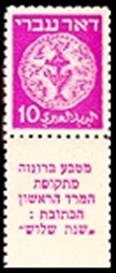
Scott: #1703-4
Issued: 5.12.2007
Philately Day - Cinemas in Eretz-Israel
Inside #1703-4 (on Tab): Pseudo Stamp

Scott: #1712P
Issued: 5.12.2007
Noah's Ark, World stamps championship
2008
Inside #1712 (In Margin): Pseudo Stamp - Logo


Scott: #1750-1P
Issued: 10.11.2008

 Inside #1750: Israel #3P
Inside #1750: Israel #3P
 Inside #1751: Israel #5P
Inside #1751: Israel #5P
The
postal ties of 1948 are reminiscent of those that existed some 100 years
earlier. On July 10, 1852 the French Postal ship Tancr?de arrived in Jaffa and
on that same day the first post office was opened by postal agent named Antonie
Louis santelli, who also initiated and founded a branch of the French post in
Jerusalem. These were the first and only post offices in the area at that time.
In 1906 an additional French Post office was opened in
On
June 9, 1948 an Air France DC3 airplane, registration number F.BAXK, landed
These
stamps commemorate the 60th anniversary of that first flight to




Scott: #1755-7
Issued: 17.12.2008
Philately Day - Ancient Letters
Inside #1755-7 (on Tab): Pseudo Stamp



Scott: #1798-1800P
Issued: 26.11.2009
Philately Day
Inside #1798-1800: Pseudo Stamp on Tab
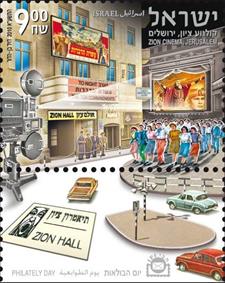
Scott: #1816P
Issued: 14.04.2010
Children's Books, London 2010
Inside #1816: Pseudo Stamp (Logo)

Scott: #????P
Issued: 3.1.2011
Israel Post Visitor Center
Inside #???? (on
label): Pseudo Stamp

Inside #???? (in
margin): TBI



Scott: #1839-40
Issued: 21.11.2010
Philately Day - Cinemas in Eretz-Israel
Inside #1839-40: Pseudo Stamp on Tab

Scott: #1909
Issued: 6.12.2011
Philately Day - The Valley Railway
Inside #1909: Pseudo Stamp on Tab

Scott: #1958
Issued: 12.12.2012
Philately Day - Energy resources in
Israel
Inside #1958: Pseudo Stamp on Tab

Scott: #1980P
Issued: 26.5.2013
Postal Vehicles in Eretz
lsrael

Inside #1980: Pseudo Stamp on envelop

Inside #1980 (in margin): Air mail
label

Scott: #1988P
Issued: 26.8.2013
Israeli Music - Children's Songs


Inside #1988l: Stamp on envelop - Self SOS

Scott: #1993
Issued: 3.12.2013
Philately Day - International Year of
Crystallography 2014
Inside #1993: Pseudo Stamp on Tab



Scott: #2040-2
Issued: 16.12.2014
Philately Day - Sundials in Eretz Israel
Inside #2040-2: Pseudo Stamp on Tab

Scott: #2086
Issued: 6.12.2015
Philately Day - The Mamluk
Postal Road
Inside #2086: Pseudo Stamp on Tab

The
Postal Road established by the Mamluk Empire in Eretz Israel (1260-1516) ran from the capital in Cairo to
the capital of the north -Damascus and other important centers. This main route
and its branches served as a means of passing news between the outlying areas
of the Empire and the capital.
The
road from Egypt, which passed through the northern Sinai Desert, forked into
two branches in Gaza - one toward Karak in Jordan via
Beit Guvrin and Hebron and the other toward Damascus
via Jitin (Ge'a), Qatra (Gedera), Ludd, Jinin, Baysan
(Belt She'an), etc.
The
Mamluk postal network was based on three components:
equestrian post, homing pigeons and fire/smoke signals. This system was called Barid. The land Barid utilized
fast horses whose sole purpose was to transport messages from the Sultan in
Cairo. The messengers who rode these horses were selected from among those
closest to the ruler.
The
fourth Mamluk Sultan, al-Zahir
Baybars alBunduqdarl
(1260-1277), who established the Mamluk Empire,
reintroduced the Barid and incorporated it into his
military structure. The peak of the Barid was during
the third reign of al-Nasir Muhammad ibn Qalawun
(1310-1341).
This
postal system was based on stations positioned at regular intervals along the
route where messengers were able to obtain fresh horses. Approaching messengers
were recognized by station personnel based on identifying marks such as a
yellow silk scarf tied to the messenger's neck, a large silver medallion
hanging from the messenger's neck or a horse with a tied tail - and were met
with a fresh horse so they could continue immediately on their journey. It took
no more than four days for the post to reach Damascus from Cairo.
In
order to minimize the obstacles en route, Baybars built and repaired bridges. This Sultan's hallmark
- the lion/cheetah - appears on many of his buildings (and also on the stamp)
and it decorated at least two of the bridges that he built: one near Carlo and
the other the Gandas Bridge near Lod
which was one of the main stations along the Barid.
The
Mamluk Postal Road left its impression on Eretz Israel and a number of impressive ruins from that
network attest to its importance as a key land bridge among various countries.

Scott: #????
Issued: 13.11.2016
Souvenir Sheet - King Solomon’s Ships
Inside #????:
Pseudo Stamp In Margin




Scott: #????-?
Issued: 19.12.2017
Philately Day - Submarines in Israel
Inside #????-?:
Pseudo Stamp on Tab



Scott: #????-?P
Issued: 28.03.2023
International Mail from the Land of
Israel

 Inside #????: Iraq #2P
(1923)
Inside #????: Iraq #2P
(1923)
 Inside #????: Iraq #8O
(1923)
Inside #????: Iraq #8O
(1923)

 Inside #????: Cyprus
#97O (1924
2 Piastres)
Inside #????: Cyprus
#97O (1924
2 Piastres)
 Inside #????: Cyprus
#93O (1925 3/4 Piastres)
Inside #????: Cyprus
#93O (1925 3/4 Piastres)
 Inside #????: Cyprus
#72O (1921 - 10 para)
Inside #????: Cyprus
#72O (1921 - 10 para)
************************************
The post of Israel issued a series of stamps on international mail
from the Land of Israel. An interesting combination of history of the post,
geopolitics, transportation, view of Israel and other relates elements. It is
more about mail in the Middle East - an area that was a remote desert than on
mail from the Land of Israel itself, but nevertheless, it is a very interesting
stamps series and most important it is a Stamps on
Stamps series.



International
mail from the Land of Israel, Issued: 28.3.2023
Immediately after the publication of the stamps and after a quick
identification of the stamps, a discussion began among the members of the club
regarding the design of the stamps and the choice, which at first glance seems
unnatural, of the envelopes that are not actually mailed
from the Land of Israel.
I sent the questions from our discussion to the designer of the
stamp Mr. Zvika Roitman,
who directed the questions to Israel Post. Within few days, I received an
in-depth, comprehensive answer from Mr. Moshe Rimer
who is the treasurer of the collection of the late Alexander Zvi, kept in the Alexander Museum of Postal and Stamp
History in Tel Aviv. https://www.eretzmuseum.org.il/e/122/
Mr. Rimer was also kind enough to send me
copies of the envelopes used to design the stamps and they are
shown here courtesy of the Alexander Collection.
Here is a free translation of Mr. Rimer's
extensive answer to the questions that came up in the discussion among the club
members as well as additional information about the thoughts behind the
spectacular design of the stamps in the series.
International mail from the Land of Israel
In the period to which the first stamp in the series refers, the
one dealing with the development of maritime mail relations, the Land of Israel
was nothing more than a remote and insignificant province of the vast Ottoman
Empire. Even during the British Mandate period, in which the other two stamps
in the series are anchored, the Land of Israel
(despite its official definition as a separate entity called Palestine) was
part of a much larger territorial unit that stretched from Egypt in the west,
through Mesopotamia to India and Australia in the Far East. The development of
international postal relations was made out of a
system of considerations that went beyond the limits of the limited Land of
Israel, and was largely derived from the imperial system of considerations of
Great Britain.
The choice of the envelopes that were
incorporated into the stamps of the series was made with deep thought on
the way in which they illustrate the position of the Land of Israel as an
international crossroads. With the exception of the first envelope, which was sent from Jerusalem, the two envelopes from the British
era were not sent from the Land of Israel, nor were they sent to the Land of
Israel as a final address, but passed through the Land of Israel as part of the
global routing system. The envelopes were carefully selected
from the huge variety kept in the collection of the late Alexander Zvi, which was deposited by him in the Alexander Museum of
Postal History and Stamps in Tel Aviv. Also the
landscape postcards integrated into the design of the stamps, which describe
the points of the settlement in which the international postal services
operated, originating from the collection of the late Alexander Zvi.
*********************
Sea mail


Envelope from Jerusalem to France
(1853)
The
publication is made with the permission of the collection of the late Alexander
Zvi,
kept in the Alexander Museum of Postal and Stamp History in Tel Aviv
The first stamp in the series focuses on the mid-fifties of the
nineteenth century, a period in which the shipping companies of Austria, France
and Russia began to visit the ports of Israel as part of the regular shipping
lines that left the mother countries and sailed to the eastern Mediterranean.
This is in the pre-stamp era, so the folded letter chosen for presentation on
the Israeli stamp has no postage stamps. The folded letter was sent on August
14, 1853 at the French post office in Jerusalem, and was transferred to the
French post office in Jaffa, where it was stamped
The rare stamp of this post office. The letter was
routed through the port of Beirut and arrived at the port of Marseille in
France on September 6, 1853.
In addition, a stamp of the Austrian Post Office in Jaffa was incorporated into the stamp's back and a photo of the
Russian mail ship "Chihachov" which ran
aground on the Jaffa coast was incorporated into the center of the stamp.
*********************
Overland mail


Envelope from the First Overland Mail
Bagdad – Haifa (1923)
The
publication is made with the permission of the collection of the late Alexander
Zvi,
kept in the Alexander Museum of Postal and Stamp History in Tel Aviv

 Iraq Scott #2 (1923)
Iraq Scott #2 (1923)
 Iraq Scott #8 (1923)
Iraq Scott #8 (1923)
The second stamp deals with the development of a unique land mail
line, initiated by the brothers Norman and Gerald Nairn.
The two brothers arrived in Israel as part of the British army in the First
World War, and decided to settle there. They were engaged in the development of
land transportation lines based on cars, which were a modern and less known
means of transportation at that time. In 1921 they
established a daily mail, cargo and passenger transport service from Haifa to
Beirut, and in light of the success of the service they decided to expand it
and establish a transportation line that would cross the arid and dangerous
Syrian desert, and lead from Haifa (the terminus of the railway line from
Egypt) through Beirut and Damascus to Baghdad (the terminus of lines the
shipping that led along the rivers of Mesopotamia and the Persian Gulf to
India).
The development of the transportation line involved a long series
of difficulties of various kinds, starting with the signing of political
agreements between the authorities of the British Mandate (which controlled the
Land of Israel and Iraq) and between the authorities of the French Mandate
(which controlled Lebanon and Syria), through the signing of agreements with
the Bedouin tribes who collected patronage fees in the territories of the Syrian
desert, And including technical problems of navigation and supplies along the
long deserted road.
On August 30, 1923, a special trip left Baghdad for Haifa that was intended to be used as proof of the applicability of the
continental mail line to the postal authorities, and based on the success of
this trip, the official contract was signed on October 18, 1923 between the
British Post Office and the company of the Nairn
brothers. Letters from this trip are extremely rare, and for
the purpose of presentation on the Israeli stamp, a registered letter sent on
this test trip from Baghdad to Haifa, and intended for an address in England,
was chosen. Two Iraqi stamps with a total face value of 9 Annas
were affixed to the envelope (3 Annas for sending a
regular letter from Iraq to England + 3 Annas for the
registration fee of the letter + 3 Annas for the
additional payment for the special service of the mainland mail).
I repeat and emphasize that the letter was not
sent from Iraq to Israel, but from Iraq to Britain, and the Land of
Israel was only a transit station that served as the terminus of the overland
mail Haifa - Baghdad. The complete line of mail delivery
included departure from Baghdad by land mail to Haifa, loading the mail on the
railway line to Egypt, and from there by ship on one of the routes to Southern
Europe (mostly France or Italy), from there by train to the ports of the Lemanche Canal, from there by ferry to Britain and from
there by train to London.
*********************
Air mail


Envelope from the First Flight Cyprus
to India (1932)
The
publication is made with the permission of the collection of the late Alexander
Zvi,
kept in the Alexander Museum of Postal and Stamp History in Tel Aviv

 Cyprus Scott #97 (1924 2 Piastres)
Cyprus Scott #97 (1924 2 Piastres)
 Cyprus Scott #93 (1925 3/4 Piastre)
Cyprus Scott #93 (1925 3/4 Piastre)
 Cyprus Scott #72 (1921 - 10 para)
Cyprus Scott #72 (1921 - 10 para)
The development of air traffic lines in the 1920s and 1930s
involved very difficult problems, both technical problems that arose from the
limited capabilities of the planes in those days and political problems that
arose from the need to sign appropriate agreements with the various political
authorities through which the air route passed. The location of the Land of
Israel placed it as a key point on the long way from Britain to the Far East,
and especially to India and Australia. Over the years, various sites in the
Land of Israel, such as Gaza, Lod, Haifa and Tiberias, have been used as
transition points for the landing and routing of cargo and passengers. On the
Israeli stamp, it was decided to show as an example
one of the routes along the line between Great Britain and India, the one that
connected Cyprus and Tiberias. This line operated for
a short period only, and was canceled due to lack of
economic viability. There are very few items of mail sent in this line, and one
of them is preserved in the Alexander collection and
is shown on the Israeli stamp. It is important to remember that the modern
concept that we are used to today, according to which a passenger on an airline
from Britain to India boards a plane in London and does not get up from his
seat until he lands in Mumbai or New Delhi, did not exist in the early 1930s.
The air route from Great Britain to India included a complex mix of a variety
of means of transportation (trains, ships and planes) which was constantly
changing, while being influenced by political decisions, technological
development, and even weather conditions. The full route was
made up of sections, some of which were made by air, such as the one
made by seaplane from Cyprus to Tiberias.

The Short S.8 Calcutta airship left Limassol and landed in the Sea
of Galilee near Tiberias.
The letter
appearing on the stamp was sent from Cyprus to Cairo,
Egypt. The sender had the option of choosing the sea route, and sending the
letter by ship from Cyprus to Alexandria and from there to Cairo. He preferred
to send it by the new air route that had just been
inaugurated, so the letter was flown to Tiberias,
from there it was transported by car to Haifa, and continued by train to
Alexandria and from there to Cairo. The air route (including the land part of
it) was faster than sailing by ship, and justified the extra payment.

The back of Envelope from the First
Flight Cyprus to India
The row of stamps stamped on the back of the letter document
the route after landing in the Sea of Galilee: Haifa, Alexandria, Cairo
The
publication is made with the permission of the collection of the late Alexander
Zvi,
kept in the Alexander Museum of Postal and Stamp History in Tel Aviv
I am attaching the questions forwarded by the club members and Mr. Rimmer's answers:
Q: Why was a letter sent from Iraq to Israel (land mail) chosen
instead of a letter sent from Israel on the stamp intended to show the
international mail from the Land of Israel?
A: Because this is an envelope that participated
in the proof-of-capacity campaign that formed the infrastructure for the
establishment of the overland mail on the Baghdad-Haifa line.
Q: Why does the airmail stamp indicate the first flight from Cyprus
to India by Imperial Airways in 1932?
A: This is an example of a route change within the full line from
the UK to India. This is a relatively rare route that
operated for a short time and landed in an unusual site on the Sea of Galilee
in front of Tiberias. The inauguration of this line
shifted the landing point in Israel from Haifa to Tiberias.
Q: The same stamp shows a letter originating in Cyprus but destined
for Egypt (air mail), is there a reason for this?
A: The letter that was sorted in Tiberias and transported to Egypt illustrates the
position of the Land of Israel as a mail routing point along the route. The sea mail letter describes a letter that left the Land of Israel,
the land mail letter shows a letter that passed through the Land of Israel
without local handling, and the air mail completes the picture with an example
of a mail item in transit that was handled and sorted through the Land of
Israel as part of an international route.
Q: Why were stamps used by the Hebrew settlement
in the Land of Israel not incorporated into the design?
A: I repeat and emphasize that the purpose was to illustrate the
historical role of the Land of Israel as a land of transit, and therefore there
was no place to select letters that originated in the Land of Israel or were
destined for the Land of Israel and were fined with
local postage stamps. This is the reason why there is no representation of the
stamps of Palestine (AI) in the envelopes. By the way, envelopes originating
from the Land of Israel are also very rare in the land mail letters, and most
of the mail that was handled by the land mail was part
of international traffic that only passed through the Land of Israel.
Summery
Since ancient times, and throughout recorded history, the Land of
Israel has been a focal point for extensive international movement between the
regional and world powers. The trade caravans between Mesopotamia and Egypt in
the ancient East, the Nabatean caravans that carried
valuable goods to the Roman Empire, the extensive trade from the Far East
during the Crusader period, and the oil lines from Iraq to Haifa during the
British period - all these reached the ports of the Land of Israel and from
there to Europe. The Arab boycott of the State of Israel interrupted this
historical sequence, but did not cancel the natural status of the Land of
Israel as a crossroads between the three continents of the ancient world. The peace agreements that have been signed in recent years reveal
the historical status of the Land of Israel, and it suffices to examine the
volume of goods unloaded in recent years at the port of Haifa and sent through
them in hundreds of trucks to the border crossings to Jordan and from there to
the rest of the Arab world.
The series of stamps denoting the international mail from the Land
of Israel is intended to illustrate the historical role of the Land of Israel,
and the items from the past that illustrate this reflect hope for a future of
peace, in which the Land of Israel will return to its natural position as a
crossroads of international trade and roads.


Scott: #????
Issued: 12.12.2023
Philately Day – 75th
Anniversary of Doar Ivri
Stamps
 Inside
#????: Israel #7P
Inside
#????: Israel #7P
In
November 1947, three graphic designers in Eretz
Israel were invited to submit proposals for the first
set of stamps that would be issued in the soon to be established Jewish State.
The stamps designed by Otte Wallish,
featuring ancient coins from the Second Temple period and the Bar Kochba revolt were selected for the State of Israel’s first
stamps. This symbolized the renewal of Jewish governance in Eretz
Israel after 2000 years in exile.
Preparations
for printing the new state’s initial stamps commenced five weeks prior to the
scheduled declaration of independence date. Those involved faced numerous
difficulties, including the need for secrecy whilst the British Mandate still
ruled in Eretz Israel, as well as severe shortages
that existed in the midst of the War of Independence. It was not clear what
should appear on the stamps, as the name of the future state was
not yet finalized when they were being prepared. On March 21, Otte Wallish prepared a stamp
that featured the name of the state as Yehuda and on March 25, he prepared
another version in which the name appeared as Eretz
Israel. Eventually, a compromise was reached and the
more neutral Doar Ivri
(Hebrew Post) appeared on the first stamps.
The
original intention was to print the stamps at the large, modern Levin Epstein
printing house in Bat Yam.
However,
the road from Tel Aviv to Bat Yam was subject to attacks from the Arab sections
of Jaffa. Therefore, the postal company printed them in an abandoned printing
house in the Sarona colony,
previously operated
by German Templers before the British evacuated them. The Haaretz
newspaper printing press manager agreed to lend the postal company one machine
and transferred it under cover of darkness to Sarona.
On
May 4, 1948, they began printing the stamps. A reporter for Haaretz
was present and described the atmosphere: “A room in a small shack. An
automatic printing press clacking monotonously. Workers doing their jobs at two
hole-punch machines... a woman sitting at a small desk in the corner counting
sheets of colored paper... the work was shrouded in the anxiety of secrecy.
People walking silently, speaking in whispers, the faint sound of machinery,
the special location at a distance from the city – all enhanced that sense of
secrecy”.
A
photo of that occasion appears on the stamp, featuring designer Otte Wallish on the right, with
the postal company supervisor Dr. Moshe Hazaki
standing to his left, alongside a printing press operator as they examined the
new stamps. A Doar Ivri
stamp with a nominal value of 250 mils is in the background and the stamp tab
features the plate with which it was printed. Today, the printing plate and the
original printing press are on display at the Alexander Museum of Postal
History and Philately at MUSA Eretz Israel Museum Tel
Aviv. A photo of the printing press appears on the First Day Cover, as well as
a sheet of Doar Ivri stamps
with a nominal value of 1000 mils in the background. The strenuous task was completed on time, and on Sunday May 16, 1948, the Doar Ivri stamps went on sale at
all post offices belonging to the newly founded State of Israel.

Best website
related:
Stamps
Catalog
http://israelphilately.org.il/en/catalog/stamps
New
Philatelic Issues
http://www.israelpost.co.il/PostBoolaee.nsf/HanpakotViewEng?openview&L=EN&mo=4
KKL Stamps Catalogue (Hebrew only)
http://www.kkl.org.il/bulim/stamps-catalogue/
![]()

Stamp Exhibition -1945

Touring Stamp Exhibition -1950






Issued: 13.09.2011 Children's Games
Wish List







